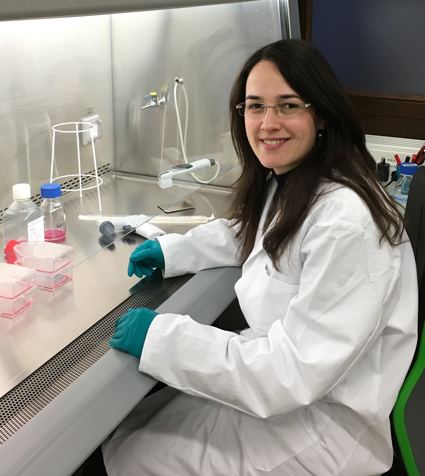
Liliana Matos, Portugal
Postdoctoral researcher - INSA, Porto, Portugal
Lysosomal storage disorders (LSDs) are a group of inherited metabolic disorders that can result in severe and progressive pathology due to a specific lysosomal dysfunction. In several patients, splicing mutations have been identified and some of these are rare (almost family-specific), but frequently associated with particular types of LSDs worldwide. Some treatment strategies are already available for conventional LSDs, but yet with some limitations. Therefore, for splicing mutations, splicing therapeutics might represent a crucial option or an important adjunct of other treatments. In the last few years our group have been developing RNA-based innovative therapeutic approaches for some LSDs. Recently, we started a study to develop a therapeutic strategy to correct by adaptation of U1 snRNA two 5’ splice site (ss) mutations, the c.1650+5G>A in the IDUA gene and the c.3335+6T>G in the GNPTAB gene, found in a Mucopolysaccharidosis I (MPS I) and Mucolipidosis III alpha/beta (ML III alpha/beta) patient, respectively. The presence of both mutations leads to exon skipping, a defect that we tried to correct in both cases through the transfection of different modified U1 snRNAs in patients’ fibroblasts. As no alteration in splicing was observed after treatment, due to a probable low efficacy of lipo-mediated transfection, we intend to try the therapeutic rescue of both mutations through lentiviral transduction, a technique with high proven efficiency in the acquisition of external vectors.
Being part of the COST Action BM1207 was important for this work since it opened the possibility to do a short term scientific mission (STSM) in a foreign laboratory where the lentiviral transduction technique is already developed. From the 30th of January until 3rd of March 2017, I have been to the lab of Human Genetics at the University of Oldenburg, where I was hosted by Prof. John Neidhardt and worked with Dr. Christoph Jüschke. The main aim of my STSM was to learn and perform the lentiviral transduction technique of different adapted U1’s into patients’ fibroblasts to try the therapeutic rescue of the 5’ss mutations, c.1650+5G>A and c.3335+6T>G. For this purpose, I started to successfully clone into the lentiviral vector the several U1 modified cassettes that were already constructed in the pG3U1 vector. Then, I carried out the HEK293T cells infection for lentivirus production and finally I have learned and performed the lentiviral transduction of human control and patients’ fibroblast cells. The results of the real time quantitative PCR’s (estimation of lentiviral copy number inserted) and the fluorescence images (GFP-positive) indicated that the lentivirus transduction was successfully achieved, but the cDNA analysis of the different cases in study showed that there was no alteration on the splicing pattern. However, the results obtained after parallel transductions of a fully modified U1 lentivirus in fibroblasts of a patient with Bardet-Biedl syndrome used as positive control (Schmid F. et al., 2011) demonstrated that our results need to be further optimized.
During my 5-weeks stay I had also opportunity to attend the lab meetings of the group, which were very useful to broaden my scientific knowledge since their research focus is not on the LSDs field, but in the clinical group of neurosensory diseases (eye diseases, hearing deficits, etc). In one of these meetings I gave them what seems to have been an appreciated talk about some important aspects of LSDs, previous obtained results of my group and on the main aim of my STSM.
Although I am experienced with cloning, cell culture and transfection techniques, during my visit I observed and learned how these techniques are performed in the Human Genetics lab. To visit a lab abroad is always a very constructive experience; there is always something else to learn.
It is also important to mention that this STSM promoted a fruitful and continuous collaboration with the group of Prof. Neidhardt. I am grateful to the Human Genetics team for the hospitality with which they have received me and for the sympathy shown during all my stay.
In summary, this STSM was very productive and crucial to get the preliminary results of the lentiviral transduction of different modified U1’s into MPS I and ML III alpha/beta patients’ fibroblasts to try the therapeutic rescue of the 5’ ss mutations c.1650+5G>A and c.3335+6T>G. Furthermore, the acquisition of the transduction technique will allow its future implementation in our laboratory to be applied not only to the 5’ ss mutations in study as to other donor site mutations reported in LSDs patient’s.
March 2017
